Forum
Important Notice for New User Registrations
To combat an increasing number of spam and bot registrations, we now manually approve all new user registrations. While this may cause a delay until your account is approved, this step is essential to ensure the quality and security of this forum.
To help us verify your registration as legitimate, please use a clear name as user name or an official email address (such as a work, university, or similar address). If you’re concerned that we may not recognize your registration as non-spam, feel free to email us at with a request to approve your username.
about kuta condition
Quote from robytian on 30. June 2024, 10:56Hi David
I would like to ask about the treatment of the Kutta condition for the blade trailing edge.
In my calculations, I am following the row of vortex filaments in the spreading direction of the blade lift line and the row of vortex filaments in the chordal direction from the boundary point to the trailing edge of the blade, treating them as bound vortices. But is the row of vortex filaments in the spreading direction at the trailing edge of the blade treated as shed vortices? If so, how do I ensure that the delta gamma is equal to 0?Due to the circulation iterations and relaxation factors, it is only possible to ensure that the circulation value of the shed vortex at the trailing edge of the blade is as small as possible, but not zero, which is why shed vortex filaments are still present even in steafy wind. Is this reasonable if treated this way?
Thanks
BR,
Roby
Hi David
I would like to ask about the treatment of the Kutta condition for the blade trailing edge.
In my calculations, I am following the row of vortex filaments in the spreading direction of the blade lift line and the row of vortex filaments in the chordal direction from the boundary point to the trailing edge of the blade, treating them as bound vortices. But is the row of vortex filaments in the spreading direction at the trailing edge of the blade treated as shed vortices? If so, how do I ensure that the delta gamma is equal to 0?
Due to the circulation iterations and relaxation factors, it is only possible to ensure that the circulation value of the shed vortex at the trailing edge of the blade is as small as possible, but not zero, which is why shed vortex filaments are still present even in steafy wind. Is this reasonable if treated this way?
Thanks
BR,
Roby
Uploaded files:- You need to login to have access to uploads.
Quote from robytian on 1. July 2024, 08:26In addition ,Can I calculate the shed vortex at the trailing edge of the blade by calculating the bound circulation twice during initialization? It will be a very small value. If this is not done, the shed vorticity at the trailing edge of the blade will enter the flow field with the first calculated value of the bound vorticity.
In addition ,Can I calculate the shed vortex at the trailing edge of the blade by calculating the bound circulation twice during initialization? It will be a very small value. If this is not done, the shed vorticity at the trailing edge of the blade will enter the flow field with the first calculated value of the bound vorticity.
Quote from David on 1. July 2024, 17:51Hello Roby,
when simulating in steady wind, there is initially some shed vorticity during the transient phase at the beginning of the simulation. This transient phase is related to the impulsive start of the blade rotation, which causes the starting vortex and the build-up of the wake. Over time, this transient behavior diminishes, leading to a steady-state operating condition. In this steady state, the shed vorticity becomes zero as the temporal derivative of the blade circulation vanishes.
In QBlade there is no shed vortex element located at the trailing edge as elements should cancel out at this position. the first shed vortex element is then found in the first wake row thats newly created by the blade. See the attached image below…
BR,
David
Hello Roby,
when simulating in steady wind, there is initially some shed vorticity during the transient phase at the beginning of the simulation. This transient phase is related to the impulsive start of the blade rotation, which causes the starting vortex and the build-up of the wake. Over time, this transient behavior diminishes, leading to a steady-state operating condition. In this steady state, the shed vorticity becomes zero as the temporal derivative of the blade circulation vanishes.
In QBlade there is no shed vortex element located at the trailing edge as elements should cancel out at this position. the first shed vortex element is then found in the first wake row thats newly created by the blade. See the attached image below…
BR,
David
Uploaded files:- You need to login to have access to uploads.


